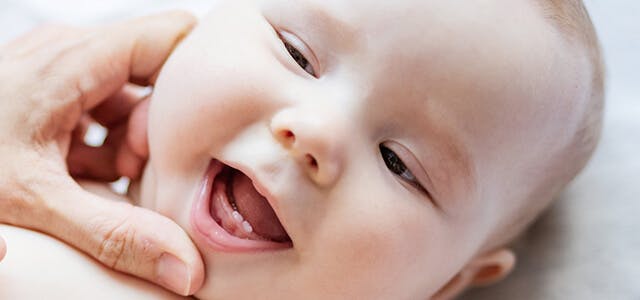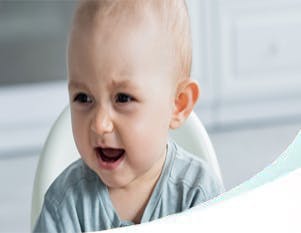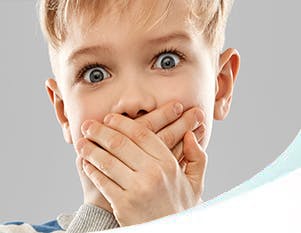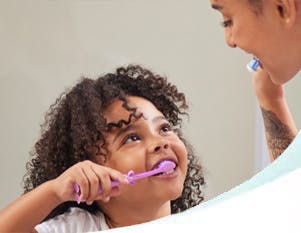When Should I Start Brushing My Baby's Teeth?
It’s never too early to start thinking about your baby’s oral health. In fact, you can start brushing their teeth with a smear of fluoride toothpaste as soon as they appear.1 Parents and caregivers can learn about caring for a baby’s teeth and gums from an early age and how to help them develop healthy dental habits.
Key Takeaways
- Start Early: Parents can begin caring for their baby's oral health even before teeth emerge by gently wiping gums after feedings and maintaining hygiene around pacifiers and utensils.
- Brush with Fluoride: Once the first tooth appears, use a baby-sized toothbrush and a rice-sized smear of fluoride toothpaste twice daily to prevent cavities and establish healthy habits.
- Know Teething Signs and Cavity Risks: Recognize symptoms like drooling and irritability as signs of teething, and understand that baby teeth are crucial for long-term dental development and alignment.
Healthy Habits Start Early
The first time your baby smiles at you might take your breath away. And while that gummy smile is perfectly cute, just wait until those first few teeth make an appearance! While your little one will be adorable no matter what, it’s important to develop healthy dental habits with your child early on. The American Dental Association and the American Academy of Pediatrics recommend these oral health tips for babies to parents and caregivers.
From Birth Until the First Tooth
After each feeding, the American Dental Association recommends that parents and caregivers carefully and gently wipe the baby’s gums with a clean, damp washcloth or piece of gauze.1 This helps to remove food particles or bacteria that may accumulate in your baby’s mouth.1
It’s also worth noting that germs and bacteria are easily spread from person to person, so adults should never put a dropped pacifier in their own mouths to clean it or share feeding spoons.1 If a pacifier falls on the floor, rinse it with water before giving it back to your baby.1
First Tooth to Three Years Old
Once your little one gets their first tooth, parents and caregivers should use a toothbrush designed for babies and a smear of fluoride toothpaste—no larger than a grain of rice—to brush twice a day.1,2,3 Once your child has two teeth that touch, make sure to clean between them so that food particles don’t get caught.1
Make sure to choose a toothbrush that’s designed for young children; it should have soft bristles, a small head, and a handle that’s easy for small hands to grip.2
When Do Babies Get Their First Tooth?
Each baby is different, but most infants will get their first tooth around 6 months of age, with the bulk of children experiencing the process of teething between 4 and 7 months.3,4,5 Babies are born with a full set of 20 primary teeth—also called baby teeth—in their jaws.4
The two front teeth on either the upper or lower jaw, usually appear first, followed by the two front teeth in the opposite jaw.4,5 These front teeth are called the central incisors, they’re often followed by a baby’s first molars and canines.5
If your little one is 6 months old and hasn’t gotten their first tooth yet don’t worry. The timing may be influenced by genetics, and it doesn’t mean anything is wrong.5 Talk to your pediatrician or a pediatric dentist if you’re concerned.
Symptoms of Teething
Your mild-mannered infant may exhibit a range of irritable symptoms to let you know that teeth are about to come in:5
- Irritability
- Mild fever below 101 degrees Fahrenheit
- Excessive Drooling
- Swollen gums around the new teeth
- Desire to chew on something hard
How Can Adults Help Relieve Teething Pain in Babies
It can be so hard to watch your baby experience discomfort. Parents and caregivers can try a few different ways to help relieve teething pain in babies:4,5
- Gently massaging baby’s gums with a clean finger, gauze, or a chilled spoon
- Clean teething rings and toys made of firm rubber
Here’s what you should never give to a teething baby and why:4,5
- Teething toys that go in the freezer can get too hard and be dangerous for gums and little mouths.
- Plastic or liquid-filled teething toys may break or develop sharp edges.
- Numbing teething gels should be avoided – in some cases they can be poisonous.
- Amber teething necklaces can lead to choking and strangulation.
- Homeopathic tablets may include harmful toxins, according to the American Academy of Pediatrics.
If you’re concerned about your little one’s comfort during teething, talk to your pediatrician or a pediatric dentist for guidance.
Can Babies Get Cavities?
If not properly cleaned, bacteria in your baby’s mouth can feed on the natural sugars in breast milk or formula and kick start tooth decay, which may lead to cavities.3 Once your baby’s teeth start coming in, properly caring for them from the get-go is important because your child’s first set of teeth are essential for chewing, speaking clearly, and setting the proper spacing for adult teeth to come in correctly.4
Research has indicated that dental hygiene habits and diet during a child’s infant and toddler years can reduce the risk of tooth decay as they become older.3 Young children who lose baby teeth to cavities may eventually need braces, as their permanent teeth may have shifted around or come in unevenly.3
How to Brush Baby Teeth
The American Dental Association has put together a few steps for caring for your baby’s teeth and keeping them cavity free:4
- Wipe baby’s gums with gauze or a damp cloth after meals
- Once the first baby tooth appears, gently brush twice a day
- Use a small soft bristled toothbrush and fluoride toothpaste
- Once your baby has two teeth that touch, clean between them with floss
Parents and caregivers can brush their children’s teeth with Pronamel Kids toothpastes for ages 2 and up. They’re gentle on enamel* and on little mouths while offering cavity protection. Help keep your children’s teeth strong and healthy with Pronamel Kids Berry Twist and Pronamel Kids Bubble Twist toothpastes.
*with twice daily brushing
Source Citations:
- Tiny Smiles: Give Kids a Smile Program. MouthHealthy by ADA. https://www.ada.org/-/media/project/ada-organization/ada/ada-org/files/resources/public-programs/give-kids-a-smile/ada-gkasts-eng_dental_professionals.pdf. Accessed 5/15/25.
- Toothbrushing Tips for Young Children. American Academy of Pediatrics. https://www.healthychildren.org/English/healthy-living/oral-health/Pages/Toothbrushing-Tips-for-Young-Children.aspx. Accessed 5/15/25.
- Why It’s Important to Take Care of Baby Teeth. American Academy of Pediatrics. https://www.healthychildren.org/English/ages-stages/baby/teething-tooth-care/Pages/How-to-Prevent-Tooth-Decay-in-Your-Baby.aspx. Accessed 5/15/25.
- Baby Teeth. MouthHealthy by ADA. https://www.mouthhealthy.org/all-topics-a-z/baby-teeth. Accessed 5/15/25.
- When Does Teething Start? American Academy of Pediatrics. https://www.healthychildren.org/English/ages-stages/baby/teething-tooth-care/Pages/Teething-4-to-7-Months.aspx. Accessed 5/15/25.





